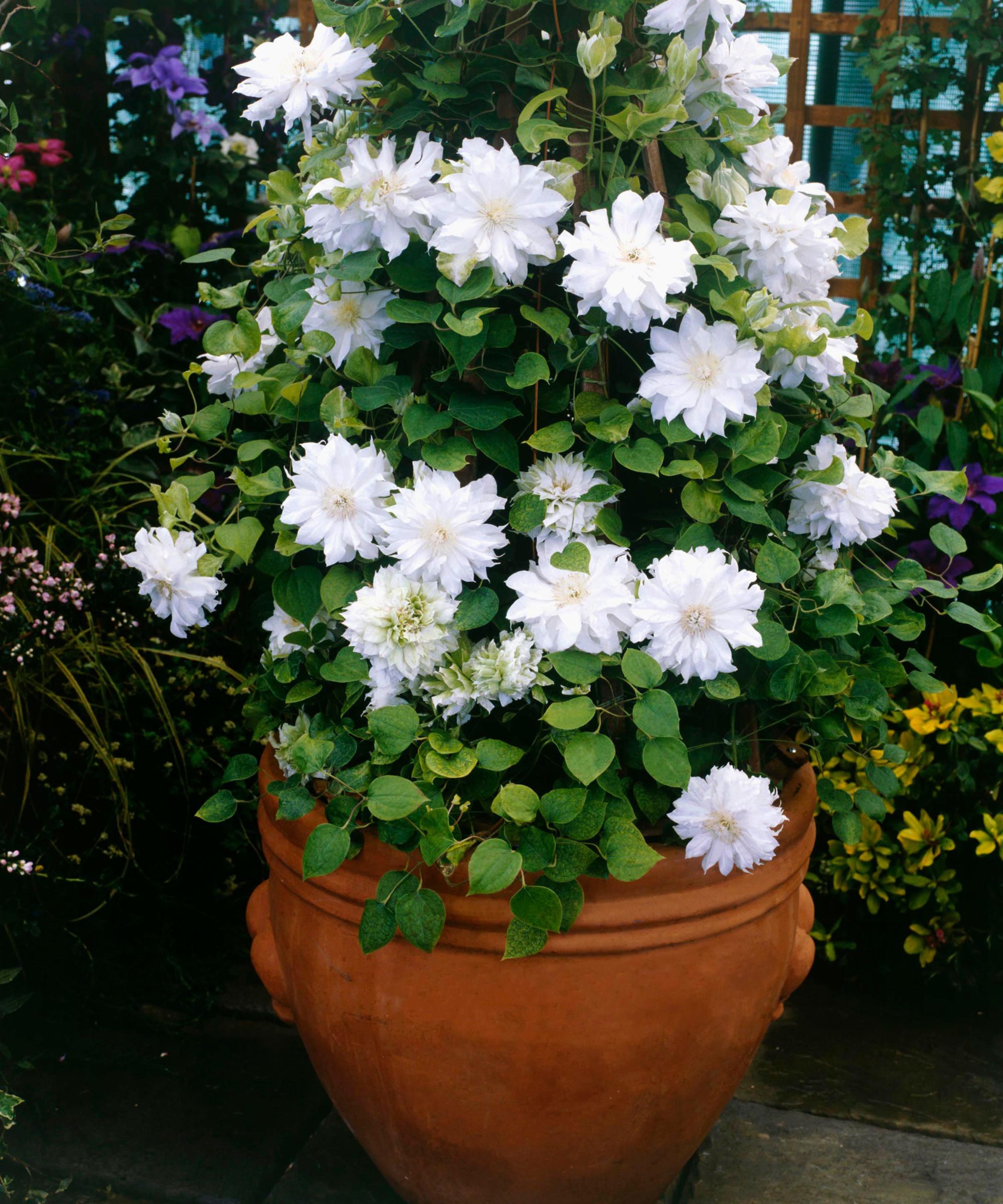
Martha Stewart's Bedford, New York farm is famous for its beautiful gardens – with the White Garden a stand-out area that we return to time and time again for inspiration.
Recently, Martha shared an Instagram post with the words, 'A beautiful white double clematis on a steel tuteur just burst into bloom in my white garden!' (below). It garnered plenty of admiration and quite a few design and clematis growing questions.
Below, we answer some of them, and look into the surge in popularity of white garden ideas – or 'moon gardens', the history of the tuteur, and the symbolism behind both.
How to get blooms like Martha Stewart's white double clematis?

Many of the questions in the comment section asked how Martha got her white double clematis to bloom so profusely.
One of the best clematis you can buy, and certainly a clematis to grow in pots, the Clematis Duchess of Edinburgh Double White, available at Walmart, will flower like Martha's if given the right conditions.
We asked our garden experts for their tips.
'Location is key to getting a clematis to bloom to its full potential and it looks like Martha has hit the sweet spot with the right location,' explains Drew Swainston. 'The roots of a clematis want to be cool and shaded, revelling in moist but well-draining soil, while the foliage and the climbing vines want sun, at least six hours a day.
'Too much shade on the foliage and it can impair the flowering. Getting that mix right is crucial and by adding other plants in the vicinity around the base of the clematis, or a good layer of mulch, that can help to shade the roots. Training the clematis up a structure allows the vines and foliage much more access to the sun that it strives for.'
'Most are self-clinging and will scramble up fences and trellises, through shrubs and up trees, creating striking planting combinations or bringing privacy to overlooked gardens,' says garden writer and author of Gardening for Shade, Tamsin Hope Thomson.
'And you don’t have to wait long to enjoy the benefits: plant a late-flowering clematis in the spring and your boundary will be covered in blooms that summer.'
This makes the tuteur – or obelisk – over which Martha's clematis is growing a useful buy for adding vertical interest and structure to a border, along pathways or either side of entrances.
Landscape gardener Deborah Silver traces the garden tuteur we see in Martha's garden back to those of ancient Egypt, via Paris' Eiffel Tower, and examines the different styles of obelisk and their various structural uses within our gardens, suggesting that visually heavier pieces work well in larger, formal gardens, and slimmer, less visually dense finds are better for smaller spaces.
'Obelisks were important in the designed landscape or pleasure garden because they punctuated the vista or provided a place from which to gain a view,' say the experts at The National Gallery of Art. They were also constructed for commemoration.
Below, we list our favorite three that resemble Martha's.
From 78in tall (there is also a taller version), this is the perfect find for small gardens, and looks beautiful without planting too.
These chunky obelisks are wonderful for training climbing fruit and veg. Choose your color or stick with solid; in various sizes.
What is the symbolism of a white or 'moon' garden?
Intentionally or not, Martha has tapped into a garden trend that's a century old: the monochromatic, white or 'moon' garden.
'Monochromatic, particularly White Gardens were popularized by renowned British garden designers Gertrude Jekyll and Vita Sackville-West at Sissinghurst Castle almost a century ago,' says H&G's head of gardens, Beth Murton.
'These types of planting schemes create what was seen then as very contemporary and clean, though now we tend to associate them with more traditional, informal but elegant English garden ideas.
'White flowers are thought to represent romance, peace, and hope.
'They also look wonderful at twilight, which is why they are often referred to as "moon gardens". You may not want an all-white garden, but white planting is a wonderful idea for borders and beds near to where you might sit out in the evening; the flowers' luminescence in moonlight is really quite stunning.
'Martha's post is bound to help these gardens find new popularity.'
Tamsin Hope-Thompson concludes: 'You can now grow clematis that have been specially bred for cutting. In the past, the twining stems have made classic clematis unsuitable for cutting; however new varieties have long, straight stems, plus an impressive vase life.'
The Clematis Duchess of Edinburgh Double White, available at Walmart is amongst these.
We know Martha would approve.







